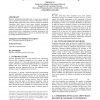153 search results - page 1 / 31 » Better Informed Training of Latent Syntactic Features |
EMNLP
2006
14 years 11 days ago
2006
We study unsupervised methods for learning refinements of the nonterminals in a treebank. Following Matsuzaki et al. (2005) and Prescher (2005), we may for example split NP withou...
EMNLP
2008
14 years 13 days ago
2008
We show that jointly parsing a bitext can substantially improve parse quality on both sides. In a maximum entropy bitext parsing model, we define a distribution over source trees,...
ICCV
2011
IEEE
12 years 11 months ago
2011
IEEE
We describe a directed bilinear model that learns higherorder groupings among features of natural images. The model represents images in terms of two sets of latent variables: one...
BMCBI
2008
13 years 11 months ago
2008
Background: Prediction of transmembrane (TM) helices by statistical methods suffers from lack of sufficient training data. Current best methods use hundreds or even thousands of f...
SIGIR
2003
ACM
14 years 4 months ago
2003
ACM
Syntactic information potentially plays a much more important role in question answering than it does in information retrieval. Although many people have used syntactic evidence i...

